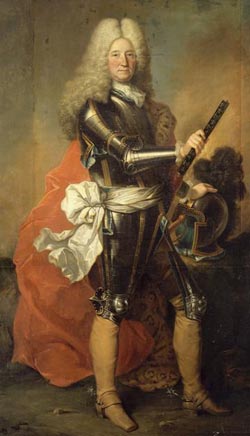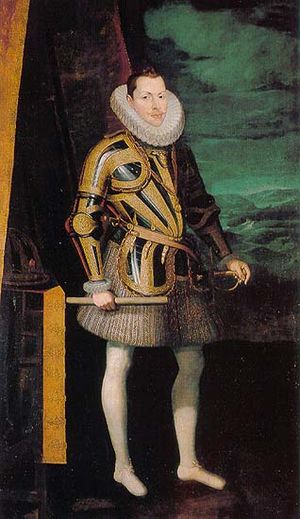حرب الاستعادة البرتغالية
| حرب الاستعادة البرتغالية | |||||||||
|---|---|---|---|---|---|---|---|---|---|
 The Acclamation of the King John IV; Veloso Salgado. | |||||||||
| |||||||||
| المتحاربون | |||||||||
|
Military Support: (1641-59)[1] (1662-68) |
| ||||||||
| القادة والزعماء | |||||||||
|
|
| ||||||||
حرب الاستعادة البرتغالية (إنگليزية: Portuguese Restoration War؛ برتغالية: Guerra da Restauração; إسپانية: Guerra de Restauración portuguesa) was the name given by nineteenth-century 'romantic' historians to the war between Portugal and Spain that began with the Portuguese revolution of 1640 and ended with the Treaty of Lisbon in 1668. The revolution of 1640 ended the 60-year rule of Portugal by the Spanish Habsburgs.[4][5] The period from 1640 to 1668 was marked by periodic skirmishes between Portugal and Spain, as well as short episodes of more serious warfare, much of it occasioned by Spanish and Portuguese entanglements with non-Iberian powers. Spain was involved in the Thirty Years' War until 1648 and the Franco–Spanish War until 1659, while Portugal was involved in the Dutch–Portuguese War until 1663.
In the seventeenth century and afterwards, this period of sporadic conflict was simply known, in Portugal and elsewhere, as the Acclamation War. The war established the House of Braganza as Portugal's new ruling dynasty, replacing the House of Habsburg who had been united with the Portuguese crown since the 1580 succession crisis.[6]
الأحداث المؤدية للثورة
When Philip II of Portugal (Philip III of Spain) died, he was succeeded by his son Philip III of Portugal,(Phillip IV of Spain) who followed a different approach to Portuguese concerns. Portuguese merchants saw higher taxes, the Portuguese nobility began to lose its influence at the Spanish Cortes, and Spaniards increasingly occupied the governments posts in Portugal. Ultimately, Philip III tried to make Portugal into a Spanish province, and Portuguese nobles stood to lose all of their power.[بحاجة لمصدر]
Moreover, Spain entangled Portugal in the efforts to suppress the independence of the Dutch Republic during the Eighty Years' War. In response, the Dutch embarked on systematic attacks on Portuguese colonies and outposts, either pillaging or occypying them in what is known as the Dutch–Portuguese War. The Portuguese felt great resentment at what they perceived as Spain prioritizing the protection of its own colonies, while neglecting the defense of the Portuguese ones.
The situation culminated in a revolution organized by the nobility and bourgeoisie, executed on 1 December 1640, sixty years after the crowning of Philip I (Philip II of Spain), the first "dual monarch". The plot was planned by Antão Vaz de Almada, Miguel de Almeida and João Pinto Ribeiro. They, together with several associates, known as the Forty Conspirators, killed the Secretary of State, Miguel de Vasconcelos, and imprisoned the king's cousin, Margaret of Savoy, who had been governing Portugal in his name. Philip's troops were then fighting the Thirty Years' War and also facing a revolution in Catalonia, which became known as the Reapers' War.
The support of the people became apparent almost immediately and within a matter of hours, Philip III's third cousin John, 8th Duke of Braganza, was acclaimed as King John IV of Portugal. The news spread like wildfire throughout the country. By 2 December 1640, the day after the coup, John IV, acting in his capacity as sovereign of the country, had sent a letter to the Municipal Chamber of Évora.
The ensuing conflict with Spain brought Portugal into the Thirty Years' War as at least a peripheral player. From 1641 to 1668, the period during which the two nations were at war, Spain sought to isolate Portugal militarily and diplomatically, and Portugal tried to find the resources to maintain its independence through political alliances and maintaining its colonial income.
الاستعدادات للحرب
Immediately after assuming the Portuguese throne, John IV took several steps to strengthen his position. On 11 December 1640, a 'Council of War' was created to organize all of the operations. Next, the king created the 'Junta of the Frontiers' to take care of the fortresses near the border, the hypothetical defense of Lisbon, and the garrisons and sea ports.
A year later, in December 1641, he created a tenancy to assure that all of the country's fortresses would be upgraded and that the improvements would be financed with regional taxes. He also organized the army, re-established the 'Military Laws of King Sebastian', and undertook a diplomatic campaign focused on restoring good relations with England.
After gaining several small victories, John tried to make peace quickly. However, his demand that Philip recognize the new ruling dynasty in Portugal was not fulfilled until the reign of his son, Afonso VI, during the regency of Peter of Braganza, another of his sons, who later became King Peter II of Portugal). Confrontations with Spain lasted 28 years.
السياق: العلاقات بين القوى الأوروبية

العلاقات بين فرنسا واسبانيا
In 1640, Cardinal Richelieu, the chief adviser to Louis XIII of France, was fully aware of the fact that France was operating under strained circumstances. He was at war with Spain at that time; he had to control rebellions within France that were supported and financed by Madrid; and he had to send French armies to fight the Spanish Habsburgs on three different fronts. In addition to their shared frontier at the Pyrenees, Philip IV of Spain, formerly Philip III of Portugal as well, reigned, under various titles, in Flanders and Franche-Comté, to the north and east of France. In addition, Philip IV controlled large territories in Italy, where he could, at will, impose a fourth front by attacking French-controlled Savoy. (In Savoy, Christine Marie of France was acting as regent on behalf of her young son, Charles Emmanuel II, Duke of Savoy.)
العلاقات بين البرتغال وفرنسا
العلاقات بين البرتغال والجمهورية الهولندية

الحرب
Militarily, the Portuguese Restoration War consisted mainly of border skirmishes and cavalry raids to sack border towns, combined with occasional invasions and counter-invasions, many of them half-hearted and under-financed. There were only five major set-piece battles during twenty-eight years of hostilities.
The war may be considered to have had three periods:
- first, an early stage (1640–1646) when a few major engagements demonstrated that the Portuguese could not be easily returned to submission to the Spanish Habsburgs,
- second, a long period (1646–1660) of military standoffs, characterized by small-scale raiding, while Spain concentrated on its military commitments elsewhere in Europe,
- third, a final period (1660–1668) during which the Spanish king, Philip IV, unsuccessfully sought a decisive victory that would bring an end to hostilities.
المرحلة الأولى: المعارك

Hoping for a quick victory in Portugal, Spain immediately committed seven regiments to the Portuguese frontier, but delays by the Count of Monterrey, a commander with more interest in the comforts of life at camp than the battlefield, squandered any immediate advantage. A Portuguese counter-thrust in late 1641 failed, and the conflict soon settled into a stalemate.
نطاق الحرب
المرحلة الثانية: توقف دفاعي

المرحلة الثالثة: الانتصار البرتغالي

By 1662, Spain had committed itself to a major effort to end the war. John of Austria the Younger, Philip IV's illegitimate son, led 14,000 men into Alentejo, and, the following year, they succeeded in taking Évora, the major city of the region.
إعادة الاستسلام
The five major battles of the war were:
- Battle of Montijo on 26 May 1644
- Battle of the Lines of Elvas on 14 January 1659
- Battle of Ameixial on 8 June 1663
- Battle of Castelo Rodrigo on 7 July 1664
- Battle of Montes Claros on 17 June 1665
The Portuguese were victorious in almost all of these engagements, and peace was concluded, with the help of English mediation, by the معاهدة لشبونة in 1668.
نتائج الحرب

For Portugal, its restoration of independence from Spain was clearly established, and it proved that it could fend for itself, albeit with difficulty. Its victories on the battlefield had re-awakened Portuguese nationalism.
Economically, Portugal's restoration of independence freed it to pursue the course mapped out by the pioneers of commercial imperialism. During the seventeenth century, its economy depended largely upon entrepôt trade in tobacco and sugar, and the export of salt. During the eighteenth century, even though staples were not abandoned, the Portuguese economy came to be based more upon slaves, gold, leather, and wine. Portuguese trade, centered in the busy port of Lisbon, was most influenced by Anglo-Dutch capitalism and by the colonial economy in Brazil.[7] Luís de Meneses, the Count of Ericeira, economic adviser to the prince regent, advocated the development of a native textile industry based on a Flemish model. Factories were established at Covilhã, in an area of central Portugal where there was easy access to flocks of sheep and clean mountain water, but they were highly unpopular with both local consumers and traditional weavers. Meanwhile, Portuguese attempts to develop a silk industry were undercut by the French, who wanted to monopolize that market.
More importantly, after 1668, Portugal, determined to differentiate itself from Spain, turned to Western Europe, particularly France and England, for new ideas and skills. This was part of a gradual "de-Iberianization", as Portugal consolidated its cultural and political independence from Spain. Portuguese nationalism, aroused by success on the battlefield, produced hostile reactions to Spain and to Spanish things and persons. By this time, Portuguese society was composed of two basic elements: those who participated in the gradual Europeanization process, the “political nation,” and those who remained largely unchanged, the majority of the people who remained apolitical and passive.[8]
Macau - the Portuguese colony in Far East, remained loyal to the Portuguese monarch during the entire occupation period, thus it was awarded title “Cidade do Nome de Deus, Macau, Nao Ha Outra Mais Leal”, or “City of the Name of God, Macau, There Is None More Loyal” by the King John IV of Portugal in 1654.[9]
انظر ايضاً
- أزمة الخلافة البرتغالية 1580
- تاريخ البرتغال (1640–1777)
- Monument to the Restorers
- Restauradores Square
الهامش
- ^ Treaty of alliance between France and Portugal concluded at Paris, June 1, 1641. Davenport, Frances Gardiner: European Treaties Bearing on the History of the United States and Its Dependencies to 1648. Clark, New Jersey: The Lawbook Exchange, Ltd., 2012. ISBN 9781584774228, pp. 324-328
- ^ Anderson, pg 131
- ^ Birmingham, p.51
- ^ Encyclopædia Britannica. "John IV (king of Portugal)".
king of Portugal from 1640 as a result of the national revolution, or restoration, which ended 60 years of Spanish rule.
- ^ Geoffrey Parker, The army of Flanders and the Spanish road, London, 1972 ISBN 0-521-08462-8, p. 35
- ^ خطأ استشهاد: وسم
<ref>غير صحيح؛ لا نص تم توفيره للمراجع المسماةTorgal 1981 - ^ The Making of Modern Europe, 1648–1780
- ^ Republican Portugal: A Political History, 1910–1926 by Douglas L. Wheeler
- ^ "Step onto Senado Square and into the past: Walking tours bring Macau's Chinese, Portuguese history in focus". South China Morning Post.
المراجع
- Birmingham, David. A concise history of Portugal (2003) ISBN 978-0-521-53686-8
- Riley, Jonathon (2014). The Last Ironsides: The English Expedition to Portugal, 1662-1668. Helion & Company. ISBN 978-1909982208.
- Anderson, James Maxwell. The history of Portugal Greenwood Press, 2000 ISBN 0-313-31106-4
وصلات خارجية
- Articles containing إنگليزية-language text
- Pages using Lang-xx templates
- Articles containing برتغالية-language text
- Articles containing إسپانية-language text
- Articles with unsourced statements from August 2019
- Articles with hatnote templates targeting a nonexistent page
- نزاعات القرن 17
- القرن 17 في البرتغال
- القرن 17 في اسبانيا
- التاريخ العسكري للقرن 17 في مملكة إنگلترة
- القرن 17 في فرنسا
- الحرب البرتغالية الهولندية
- حروب الپرتغال
- حروب اسبانيا
- حروب إنگلترة
- حروب فرنسا
- العلاقات الاسبانية البرتغالية
- حرب الاستعادة البرتغالية
- القتال في العصر الحديث المبكر


